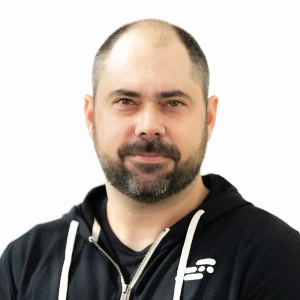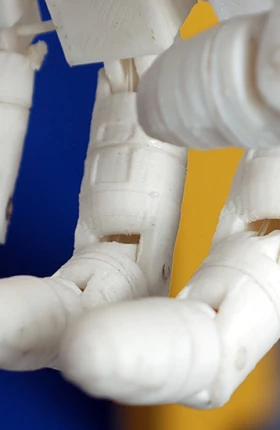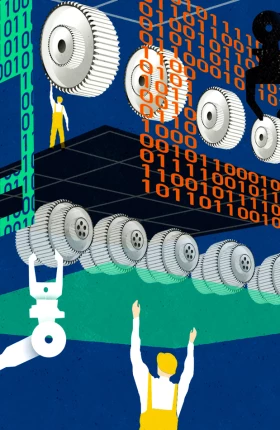Industry 4.0 advanced manufacturing systems hold the potential to radically change the economics of global production by making it more cost-effective and practical to make goods closer to where they are consumed. Sports shoe manufacturing, however, has long been one of the most difficult industries to automate.
Despite the challenges, Boston-based New Balance Athletics has manufactured athletic footwear in the US for more than 75 years. Its New Balance Made premium collection represents a portion of its US sales, and at least 70% of the value of the shoes is manufactured in the U.S. The company has also been a leader in bringing advanced manufacturing technologies to the athletic footwear industry.
Edith Harmon, New Balance’s vice president of manufacturing innovation, explained how the company is deploying digitally enabled technologies, as well as what the current limits of those technologies are in shoe manufacturing, in an interview with BCG partner Vladimir Lukic and senior writer Pete Engardio. Prior to joining New Balance in 1991, Harmon worked with the General Electric Aircraft Engine Group. She has held a number of R&D and production innovation roles at New Balance and currently leads the company’s efforts to introduce the digital factory.
Sports shoes are regarded as some of the most labor-intensive products to manufacture. Yet New Balance continues to manufacture a limited portion of its athletic shoes at its five factories in New England. Is that challenging?
Yes, but domestic manufacturing is part of our company culture, and we enjoy that challenge. I came to this industry years ago from aircraft engines. I thought footwear would be easy. But it is very complex. Sports shoe manufacturing presents almost a perfect storm for automation, but it still requires a lot of manual labor. You have to deal with the complexity of many models and with the difficulty of working with soft goods. The overall challenge in making shoes is that the tolerances, the product size ranges, and the breadth of natural and man-made materials are quite different from those in technical products.
One advantage of manufacturing in the US, however, is access to the craftsmanship that athletic shoes require. We have five factories in the US full of experienced and committed people who are very good at making shoes. Also, we have two US production lines dedicated to custom products. We can ship customized shoes to domestic consumers in ten days to two weeks, much faster than we could if we made them overseas.
How does New Balance currently use automation in the manufacturing process?
We have been very early adopters of some technologies, and that has allowed us to keep our US factories competitive and growing. In the 1980s, our domestic factories began using computerized stitching, which enables us to place materials on a pallet and deliver them to sewing machines along a digital path. And we began using 3D printing in the early 1990s.
The automated embroidery selection programs we use on our custom product lines allow us to quickly change thread colors. Other technologies help us automate the steps of attaching the molded bottom portion of a shoe to the soft upper portion. Over the past three years, we have been implementing a digitized system for tracking defects on the production line. We are also using 3D foot scanning in select global retail locations to give our customers an enhanced fit experience.
You mentioned that New Balance uses 3D printing. How is additive manufacturing currently useful for your business, and in what ways is it not yet applicable?
3D printing is now part of our DNA. It is imbedded into our product development process and is moving ahead to play an even more prominent part in our product portfolio. Each year, we make in house more than 4,000 3D prints that are used for decisions on product aesthetics and functionality. We also use 3D printing for fixtures and light tooling.
3D printing is especially valuable for making parts of customized footwear, such as plates—the molded part at the bottom of an athletic shoe that may have cleats or spikes—and cushioning materials, such as midsoles. If you can bring athletes into a sports research facility to study their biomechanics, you can capture the data, take it to a lab, and analyze it. Then you can move into a 3D creation and printing environment.
The printed custom parts we make for athletes in baseball, track and field, and soccer are amazing and well received. In 2013, we made data-customized 3D printed spike plates for middle distance runner Jack Bolas. More recently, this spring, we made a custom 3D-printed plate for Corey Kluber, the Cleveland Indians pitcher. He was the first athlete to wear cleats with 3D-printed plates in a Major League Baseball game.
The current limits to 3D are seen in finalizing a set of fully capable footwear materials and putting the technology into action on a production line. Transforming the upper part of the shoe from 2D to 3D is a complex challenge that will require some new thinking on product construction and automation. People are still working with a lot of cut parts. This is not high-speed manufacturing. There will always be some handcrafted parts. Also, we don’t yet have a full palette of different materials that can work with 3D, though there have been tremendous advances. Another priority is to reduce material waste in 3D printing.
How about advanced robotics systems?
We have been using robots for three decades. The significant challenges for robotic systems in footwear manufacturing are changeover and complexity, because of the wide range of sizes, styles, and soft materials. We work in partnership with a select vendor group of automation experts to implement technology that allows us to handle this complex manufacturing environment. The robotic systems give us control over critical operations to improve consistency and performance. They assist associates who are doing repetitive motions and make the work environment safer. As collaborative and safety options, robotic automation will play a greater role in our operations.
How are you using technology to cut down on defects?
We used to track all of our reworked parts, repairs, and failures on paper. Three years ago we started working with a system from Tulip, a developer of software for digitizing the shop floors of footwear and apparel manufacturers. We are replacing paper forms with its manufacturing apps that run on tablets or other touchscreen devices. Workers don’t need information technology expertise to use the system. They call up an image of the shoe style they are working on and note where the defects are. Our engineers can tailor the app to our exact requirements, with no programming needed. Tulip’s apps connect to our production equipment, so we are able to correlate machine and human data using the built-in analytics engine. And by giving our material suppliers clear and accurate data from the production line, we can remove ambiguity and delays when solving problems.
New Balance has already implemented lean practices and other methods that reduce waste and defects. Are there remaining gaps that can be filled by digital technologies?
We had implemented lean, but it was still very manual. When we relied on humans to record workmanship on paper, data collection was a chore. You can collect data every hour for ten years, but that doesn’t mean you can use it. The data becomes paralyzing. It is hard to get your head around all that is happening in a factory. A lot of the data gets lost. So while data can be beyond valuable, the question is, how actionable is it?
It was also hard to share the information we collected on defects between one production line and the next, let alone between factories. You end up with tribal knowledge. A deviation happens in one work unit, and that team resolves the problem and learns from it. If a supervisor resolves a problem offline, it’s like having a hidden factory. You can’t perform a gap analysis. And the problem could be much bigger because a team that solves a problem on its own doesn’t have data on the root causes.
We weren’t tackling problems on a consistent basis—problems popped up and dissipated. The same problem could arise in another value stream in another location, but we didn’t see the connection. Production lines in Maine and Massachusetts could use different countermeasures to move forward, not knowing they were creating a defect somewhere else.
With Tulip, we are now able to capture all this real-time data and get visibility into the root causes of production issues. We now have a lot more confidence in the data, and we can digitize the analysis. We can feed it all the way back to the designer. We can use the data to track production factory to factory and value stream to value stream. We can also digitize our lean practices and promote standardized work throughout our facilities to better measure quality and performance.
Do you envision New Balance moving toward an end-to-end, Industry 4.0 solution?
Right now, we are bringing on individual pieces of technology because we need to maintain flexibility. We are transforming manual processes one at a time and bringing on board individual pieces of equipment that we can quickly deploy in our factories.
But an end-to-end solution is our North Star. We are also looking at how to connect individual solutions using a digital backbone for a more comprehensive approach. We are moving toward taking digital from design all the way to the factory floor. This is a very ambitious goal—it may not be for every product, however.
For sure, the system will still need to be flexible because we have a very diverse product offering. We are focused on getting products to the consumer more quickly. Our goal is to create hybrid solutions that will let us flex between analog and digital approaches as needed.
How does New Balance work with the external supplier ecosystem for Industry 4.0?
Our approach is to find key partners for various projects, since we don’t have the software expertise to develop all solutions in house. Key partners include Tulip for digital factory management, Nervous System for data-to-design support, and IPSUMM for robotics. These are examples of local New England companies that we work with closely. We are very open to working with startups and companies of all sizes. Our challenge is to keep up with the short-term needs of our manufacturing facilities while keeping an ear to the ground and providing space to explore more long-term opportunities.
What are the implications of Industry 4.0 for your workforce? Is it difficult to find workers who can handle advanced manufacturing technologies?
We still need people who understand craftsmanship. Of course, over the past 20 years, we have hired more specialists in areas like IT, engineering, and industrial design. If you are making a sole-printing unit, for example, you need somebody with a PhD in plastics.
But we don’t see people as a big stumbling block. Regardless of where our people are in their technology journeys, they want to learn and work with the new technologies. One reason people are reacting well is because the user interfaces on software are helpful and familiar.
The people now entering the workforce grew up in a digital world. The millennial workforce has always had technology at their fingertips and is very comfortable using cloud-based software. They see new technologies as challenges that they can learn from. They want to join companies where they can leverage these skills and interests. Our gamification of the factory floor and placement of tools in the hands of our technicians, engineers, and craftspeople will certainly make us more competitive and attractive as an employer.
A lot of the talent issue has to do with developing your workforce and partnering with universities. We are very active in training people through internships. We also work with several universities on research projects.






